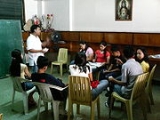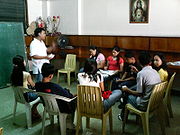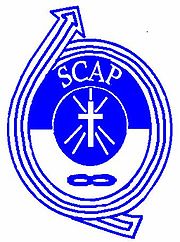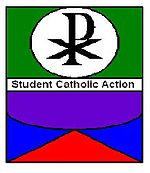
Student Catholic Action
Encyclopedia

Philippines
The Philippines , officially known as the Republic of the Philippines , is a country in Southeast Asia in the western Pacific Ocean. To its north across the Luzon Strait lies Taiwan. West across the South China Sea sits Vietnam...
. Its affiliation overseas is the International Young Catholic Students (IYCS), also known as International Young Christian Students in Asia that follows the methodology of Cardinal Joseph Cardijn
Joseph Cardijn
Joseph Leo Cardijn was a Belgian priest and cardinal and the founder of the Young Christian Workers.-Biography:...
, the see-judge-act methodology. Known to be the first student religious organization in the Philippines and presently known all over the Philippines through local dioceses and catholic schools (public & private high schools).
History
The BEGINNINGSince it was founded in 1936, Student Catholic Action has undergone a gradual process of development and expansion. Evolving from a loosely formed city-wide association in the early years it has now established itself as a well knit organization with SCA Chapters in practically all educational institutions in the Archdiocese of Manila.
Demonstrating adaptability as one of its main assets, SCA first concerned itself with the problem of education in the state university. It was here that the first unit was formed by Columban Father Edward J. McCarthy in 1936.
Later that year the organization extended its objectives to the preparation on Manila’s students for intelligent and devotional participation in the 33rd International Eucharistic Congress.
Formally approved on April 12, 1936 by His Grace, Archbishop Michael O’ Doherty, SCA concentrated its efforts during the remaining pre-war years on the organization of religion classes in non-sectarian schools with special student Masses in Sta. Cruz Church. In addition, the Catholic youth of Manila were alerted to the problems of their environment through annual rallies and regular convocations.
DORMANT STAGE and SUSPENSION
During the occupation era the impetus of the early enthusiasm of SCA maintained the organization for a short time. Registered with the Japanese authorities “SCA for secular colleges and universities,” the organization continued with its regular student Masses but eventually, due to lack of priestly assistance, all activities gradually ceased.
REVIVAL and EXPANSION
After the war, in 1948, SCA was recognized by Columban Father James V. MacDevitt at the request of the Archbishop of Manila. With the immediate objective of establishing religion classes in non-sectarian and public schools, SCA was first organized in Catholic schools for the main purpose of providing the many catechists required for this work.
In 1949, the post-war SCA was formally inaugurated at UST Chapel with 18 Catholic schools forming the nucleus of the organization. In the twenty post-war years the number of school members in the Archdiocese of Manila has increased to 138 including Catholic, non-sectarian and public schools. During the same period SCA has been extended to practically all the archdioceses and dioceses throughout the Philippines.
CONSOLIDATION
In 1950, the First SCA Leadership Conference was held in Baguio. Two years after, it was mandated by the Philippine Hierarchy as member of the Catholic Action of the Philippines. Then the SCA affiliated with the Pax Romana International Movement (known today as International Movement of Catholic Students, IMCS) in 1955. It affiliated with the International Young Christian Students (IYCS) the next year. The start of the Leadership Training Schools initiated by Fr. Michael Nolan, SSC in 1957 marked SCA Golden Age. The movement hosted the Pax Romana International Conference held in Manila from December 26, 1960 to January 9, 1961. It was participated in by more than 44 countries all over the world. The First SCA National Congress was convened in Iloilo from May 24 to 29, 1962.
With this continued expansion and increasing influence of SCA there naturally followed added responsibilities and new activities. Whereas the early post-war years the main activity was catechetical instruction, this now is but one of many varied activities embraced in the six aims of SCA (now called as the SCA Areas of Concerns), though it is still very important and vital one.
SCA in 1967 has assumed the role and accepted the mandated responsibility of uniting all apostolic Catholic students in all educational institutions for the intensification of the Catholic way of life in their respective schools and in the student community as a whole.
CRISIS
SCA started to experience crisis in 1969. The heightened student activism affected SCA especially the Martial Law years where the movement’s idealism was infiltrated by the left orientation in 1976. Student organizations like SCA were banned.
NEW LIFE
In 1978, the Campus Ministry, which traces its roots from SCA, was introduced. SCA still existed but had different names then. The religious instruction was officially allowed and catechists were organized. The direction stressed on non-violence formation and training.
The SCA called for a National Conference in Cebu in 1980. It called for a National Constitutional Convention, the last attempt to retain the national coordination, held in Manila in 1984. The next years were difficult time for SCA, it was then when the national coordination was disbanded. The diocesan coordination and units in the different parts of the country continued to exist though.
The growing need for SCA national coordination was strongly felt as years went by. With this, in the January 1989 National Conference of Youth Ministers (NCYM), the rest of the active SCA diocesan groups presented and passed a resolution requesting the Episcopal Commission on Youth – National Secretariat for Youth Apostolate (ECY-NSYA) to take charge of coordinating the existing SCA units nationwide. As a result, a national consultation meeting of SCA materialized in July 1989 spearheaded by the NSYA. Fr. Jose Sumampong of Diocese of Tagbilaran was appointed as National Chaplain of SCA.
The SCA now holds archdiocesian, regional, and national conferences and now present in more than thirty dioceses in the Philippines.
The Logo

The border, consists of three paralleled lines and starting from left-below to form an imaginary spiral movement and ending to form an arrow towards top-right represents the following:
Three lines. The three parallel lines starting from left-below, represents the three major regions of the country, namely: Luzon
Luzon
Luzon is the largest island in the Philippines. It is located in the northernmost region of the archipelago, and is also the name for one of the three primary island groups in the country centered on the Island of Luzon...
, Visayas
Visayas
The Visayas or Visayan Islands and locally known as Kabisay-an gid, is one of the three principal geographical divisions of the Philippines, along with Mindanao and Luzon. It consists of several islands, primarily surrounding the Visayan Sea, although the Visayas are considered the northeast...
and Mindanao
Mindanao
Mindanao is the second largest and easternmost island in the Philippines. It is also the name of one of the three island groups in the country, which consists of the island of Mindanao and smaller surrounding islands. The other two are Luzon and the Visayas. The island of Mindanao is called The...
. Their being parallel with each other is recognition of the difference in culture and belief between the three major regions. However, their common faith in the Lord Jesus Christ as savior, shall motivate all of us to move simultaneously and hand-in-hand in pursuit of our quest for a truly Christian life.
The Second part of the border, where the parallel lines converge to form an arrow, represents the HOLY TRINITY. Three different persons, the Father, Son and the Holy Spirit in One God.
The Imaginary Spiral Movement of the Border. This movement represent the dynamism in the SCAP where we have to See every situation we encounter in our lives, Judge the situation relative to our Christian faith and Act in accordance with the will of the Almighty. We have to adopt to the ever changing environment and the intricacies of life.
The Movement from Below to the Top . We have to move from where we are now, towards our aspiration for Holiness and be more like Jesus Christ. A call for every SCAn to enrich and sustain one’s relationship to God through prayers, participation in the Holy Mass, recollection, reading the Bible and other activities of the Catholic Church towards that end.
The Movement from Left to Right. As SCAns, our actions must emanate from our hearts toward righteousness and service to the people. "We have to love one another as God love us."
The Colors White and Blue represent the movement’s recognition of Mary’s great role in the fulfillment of God’s plan for salvation. Mary is the SCAP’s inspiration for obedience to God’s will.
Archdiocese of Manila

Affiliations
The Student Catholic Action has been affiliated with the following federation and associations:- AYOM - Archdiocesian Youth Organizations and Movements
- CM - Campus Ministry
- FNYO - Federation of National Youth Organizations
- MYA - Ministry of Youth Affairs
- CODE-M - Coalition for Decency and Morality-Youth
- EASYNet -Ecumenical Asia-Pacific Youth and Students Network (PhilNet)
External links
- Student Catholic Action of the Philippines Official Website
- International Young Catholic Students (IYCS)
- International Young Catholic Students Asia (IYCSA)
- Student Catholic Action of the Philippines (SCAP)
- Student Catholic Action Archdiocese of Manila Blog (SCA-AM)
- Manuel S. Enverga University Foundation - SCA
- Holy Name University Student Catholic Action
- University of Bohol Student Catholic Action

